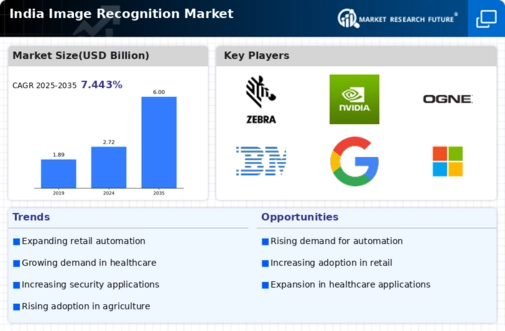Surge in E-commerce Activities
The rapid expansion of e-commerce in India is a pivotal driver for the image recognition market. As online shopping continues to gain traction, retailers are increasingly adopting image recognition technologies to enhance user experience. This technology facilitates visual search capabilities, allowing consumers to find products through images rather than text. According to recent estimates, the e-commerce sector in India is projected to reach $200 billion by 2026, which could significantly boost the demand for image recognition solutions. Furthermore, the integration of augmented reality (AR) in e-commerce platforms is likely to enhance customer engagement, thereby propelling the image recognition market forward. The ability to visualize products in real-time through images may lead to higher conversion rates, making this a crucial area for investment in the image recognition market.
Integration of Smart Devices and IoT
The proliferation of smart devices and the Internet of Things (IoT) in India is creating new avenues for the image recognition market. As more devices become interconnected, the need for advanced image recognition capabilities to process and analyze visual data is increasing. Smart cameras, drones, and other IoT devices are being deployed in various sectors, including agriculture, manufacturing, and logistics, to enhance operational efficiency. The Indian IoT market is expected to grow to $15 billion by 2025, which could significantly impact the image recognition market. The ability to analyze images in real-time from multiple sources may lead to improved decision-making and resource management, thereby driving further adoption of image recognition technologies.
Advancements in AI and Machine Learning
The ongoing advancements in artificial intelligence (AI) and machine learning (ML) technologies are transforming the landscape of the image recognition market. In India, the increasing availability of sophisticated algorithms and computing power is enabling businesses to implement more accurate and efficient image recognition systems. These technologies are being utilized across various sectors, including retail, automotive, and healthcare, to automate processes and improve decision-making. The Indian government has also been promoting AI initiatives, which may further stimulate growth in the image recognition market. As organizations seek to leverage AI for competitive advantage, the demand for image recognition solutions is expected to rise, potentially leading to a market growth rate of over 30% annually in the coming years.
Growing Interest in Personalized Marketing
The increasing focus on personalized marketing strategies in India is another key driver for the image recognition market. Businesses are leveraging image recognition technology to analyze consumer behavior and preferences, enabling them to deliver tailored marketing campaigns. By utilizing visual data, companies can create more engaging advertisements and improve customer targeting. The Indian digital advertising market is projected to reach $10 billion by 2025, suggesting a robust opportunity for image recognition solutions. As organizations strive to enhance customer experiences and build brand loyalty, the demand for innovative image recognition applications is likely to rise, positioning this technology as a critical asset in the marketing landscape.
Rising Demand for Enhanced Security Solutions
The growing need for enhanced security measures in India is driving the image recognition market significantly. With increasing concerns over safety and security, businesses and government agencies are investing in advanced surveillance systems that incorporate image recognition technology. This technology enables real-time monitoring and identification of individuals, which is crucial for crime prevention and public safety. The Indian security market is projected to reach $15 billion by 2025, indicating a substantial opportunity for image recognition solutions. Moreover, the integration of facial recognition systems in law enforcement and public spaces is likely to further propel the demand for image recognition technologies, making it a vital component of the overall security infrastructure.

















Leave a Comment